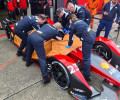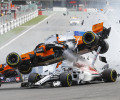AUTO+ Medical - Safety in our HANS
How the HANS device revolutionised driver safety and will continue to do so as a lasting legacy of Dr Robert Hubbard

Dr Robert Hubbard sadly passed away in February this year but he leaves behind a strong legacy in motor sport that has transformed driver safety and will continue to do so as the technology he invented is developed even further.
Hubbard’s Head And Neck Support (HANS) device was the original Frontal Head Restraint (FHR) and these devices have become an integral part of motor sport, helping many drivers to survive numerous severe accidents. Since becoming mandatory in most forms of motor sport over 15 years ago, FIA research has shown they have helped to minimize head and neck injuries and virtually eliminate all instances of catastrophic injury to the craniovertebral junction (CVJ), which were previously a common cause of death in racing.
“The HANS has been one of the major safety devices introduced in motor sport,” says FIA Head of Competitor Safety, Nuno Costa. “The FIA has studied a number of accidents and for some of them we estimate that the drivers and co-drivers would not have survived without the use of FHR devices.”
Life Support
Hubbard was the engineer behind HANS, which was designed to prevent head and neck flexion-distraction injuries during high-velocity frontal accidents. The idea for HANS was initially brought to Hubbard by his brother-in-law and sportscar racer Jim Downing, after the death of one of his friends taking part in an American Le Mans sportscar race due to head injuries.
Downing believed that protection was necessary for drivers to help prevent injuries in sudden stops, where a driver’s head would thrust forward too far, causing injuries from severe whiplash to basilar skull fractures. The first designs of the HANS device were conceived in the 1980s and after further testing, with help from General Motors and Ford, interest came from the FIA during 1994 as part of its targeted focus on safety in Formula One.
A significant turning point was when NASCAR legend Dale Earnhardt died due to head injuries during the 2001 Daytona 500. Following Earnhardt’s death, it was not long before FHR devices became a familiar sight on drivers, with sales of the HANS increasing from 250 in the first 10 years to over 3,000 by the end of 2001.
IndyCar and NASCAR were among the first to make it mandatory. Since its introduction, there have been no deaths relating to CVJ injury in either championship.
In F1 it was made mandatory for use by all drivers in 2003, with it later playing a key role in protecting Robert Kubica during his massive crash at the 2007 Canadian Grand Prix. WRC shortly followed in 2005, before the FIA mandated the use of HANS in all of its major championships running with modern cars from 2008 onwards.
Although the early iterations of the HANS were branded too bulky and uncomfortable to wear by drivers during the extreme forces and accelerations imparted by motor racing, over the years various enhancements and adjustments have been made to improve the design.
These include sliding tethers that improved driver comfort, significant weight reductions, new materials, and a revised shape for the HANS collar. One noteworthy version of the HANS device was the introduction of the Adjustable HANS in 2013, which allows the adjustment of the HANS collar depending on the driver’s seat position in the cockpit.
Hybrid system
Initially the HANS was the only FHR device accepted by the FIA. However, from 2010 it approved an alternative frontal head restraint system for competitive racing, known as the Hybrid. The Hybrid device was added to the FIA Technical List and has become popular particularly for drivers and co-drivers who participate in rallying.
The Hybrid (and Hybrid Pro) was developed by Safety Solutions Inc now owned by Simpson Motorsport. Both use a combination of straps around the driver’s body to maintain the position of a rigid collar, which provides a load path from the shoulder belts to the helmet using flexible tethers.
As for the HANS, the Hybrid is designed to protect during both frontal collision and angled-frontal impacts. Some drivers find it more comfortable, particularly with upright seat types and it is used by a number of rally drivers or co-drivers, as it allows them to easily remove their helmet for road sections and keep the device attached to their body.
To ensure that innovation can continue leading to the next generation of FHRs, the FIA has set up an FHR Panel comprised of world-leading experts who evaluate the safety performance of alternative frontal head restraint devices based on laboratory testing.
“The FIA’s target is to ensure that any new device joining the programme provides at least the same safety level as that of the current FHR devices,” says Costa. “Once the panel of experts takes a decision on a new device concept, the FIA safety department team designs the test procedures and pass/fail criteria, which are based on quasi-static tests.”
The FHR devices are then tested in an FIA approval laboratory and a comprehensive homologation dossier, along with a test report, is submitted to the FIA safety department. “The competitor safety group analyses the homologation dossier and takes the decision on whether or not the device can be homologated,” explains Costa. “As for any FIA-approved safety product, we also monitor the use of the FHR devices at the track as well, ensuring that the device is still meeting the FIA safety requirements.”
Future steps
The FIA is targeting 360-degree protection for both drivers and co-drivers, with both the HANS and Hybrid offering frontal impact protection up to 30-degrees. Having approved a new research project last year, the FIA hopes to improve the performance of FHR devices by 2020.
“We are planning to look at the FHR basics, at the design and safety performance best practices,” says Costa. “The objective is to gather the feedback from drivers and teams, FHR manufacturers, the doctors and safety delegates with the target to improve the frontal impact performance, reduce the risk of misusing devices, increase the stability of performance for a heterogeneous range of end-user conditions and improve the comfort.”
Another area that the FIA aims to improve is the equipment cost for competitors. During 2016, Motorsport UK agreed to make HANS mandatory for all national championships; before this time, it was viewed as being cost prohibitive risking reduction in numbers of competitors. Even though the FIA has no direct control on costs, it works with manufacturers to help make safety equipment more affordable without any compromise on the quality or safety performance.
“By writing the safety regulation in a way that allows the manufacturers to design new models with novel materials and processes, the FIA incentivises the introduction of cheaper devices while guaranteeing the minimum safety performance,” says Costa.
The FIA together with the FHR manufacturers ran a monitoring programme a few years ago to verify that old devices were (still) delivering the minimum safety performance required by the FIA safety standard. “We concluded that the devices that were not subject to high stress during severe crashes maintain their safety performance over time,” says Costa. “Therefore, the FHR devices continue to not have a validity date, and this provides a further measure which keeps the cost down for the competitors.”
Although the HANS had an initially slow birth into motor sport, it was instrumental in establishing FHR devices as an essential part of a driver’s safety equipment. Every top-level driver wears some form of frontal head restraint, and with the additional work being done by the FIA this will continue to be the case.
It is not precisely known how many drivers in categories around the world owe their lives to the work conducted by Hubbard, but it is safe to say that their survival acts as a tribute to his ongoing legacy.
You can read the full issue of AUTO+ Medical here.

 Facebook
Facebook Twitter
Twitter






